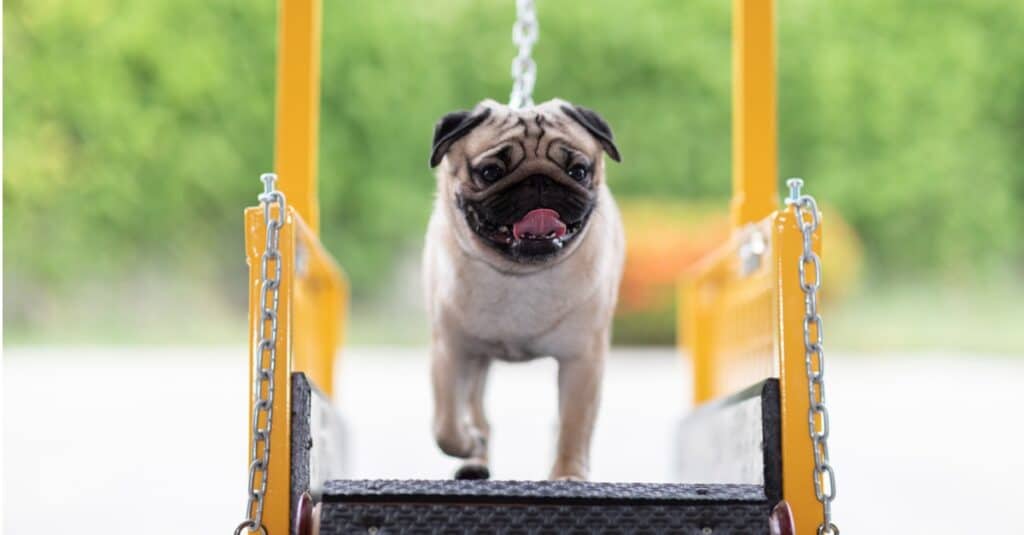Welcome to our comprehensive exploration of pug intelligence. In this article, we delve into the intriguing world of these adorable canines, examining their cognitive abilities, problem-solving skills, and unique traits that make them one of a kind. Join us as we uncover everything there is to know about how smart pugs truly are.
History of Pugs

Pugs have a high level of companionship intelligence. They are sensitive to their human companion’s emotions.
©TatyanaPanova/Shutterstock.com
The Pug Dog is a very old breed that dates back approximately 2,000 years. It was popular amongst Chinese emperors and was often gifted to outsiders. It wasn’t until around the 1500s, when Dutch traders brought Pugs back to Europe, that they became popular worldwide. There is a legend that claims a Pug saved the life of the Prince of Orange by alerting him to an attack from Spanish troops!
The global popularity of pugs is obvious from the many names that people use to refer to them in different places and times. People call pugs Lo-Sze in China, Doguillo in Spain, and Mopsi in Finland. Notably, the Dutch still refer to them as Mophonds. It is believed that the name “Pug” has its origin in the Latin word “pugnus,” which translates to “fist,” indicating that the shape of the dog’s face compares to a clenched fist.
Exploring the Intelligence of Pugs

Pugs are affectionate and easy-going, making them excellent family dogs.
©Africa Studio/Shutterstock.com
The pug is a much-loved canine breed that has gained worldwide admiration. Their Latin phrase ‘multum in parvo’ means a lot in a little and accurately sums up their small yet muscular physique. They mainly come in three colors: all black, silver, or fawn (sometimes called apricot) with a black face mask. They have a human-like expression, which often shows surprise, joy, and curiosity. Pugs are excellent house pets as they are suitable for all types of households (city or country, kids or elderly, single pet or pack). However, it is important to watch their diet so they don’t gain too much weight.
But are pugs smart? Let’s dive in a little deeper and explore the intelligence of these lovable little dogs.
The Cognitive Capabilities of Pugs: Understanding Their Problem-Solving Skills and Brain Size

Pugs are the perfect type of dog to have if you need a charming, amusing, and affectionate companion.
©Khilenko Anastasiia/Shutterstock.com
Pugs, the beloved dog breed, have an endearing and distinct look. Although they may not be the smartest dogs on the block, pugs are intelligent and capable of problem-solving. They have an impressive brain size for their body size, allowing them to think and act quickly.
Pugs are capable of learning basic commands, and you can train them to do more complex tasks, such as opening doors and fetching items. They can remember instructions and will often use problem-solving skills to figure out how to get what they need. For example, a pug may try to open a door knob if it’s behind a closed door.
Pugs also have an excellent sense of smell. They can pick up on scents from long distances and sniff out drugs and explosives. They can use this skill to find their way home or locate hidden objects.
Pugs possess a lot of natural intelligence, but their small size often prevents them from performing tasks that require physical strength. However, their problem-solving skills are not limited by size, and you can teach them to use their natural intelligence in ways that can help them in everyday life.
Pug Learning Aptitude: How Quick and Adaptive Are They?

Although sometimes stubborn, pugs are certainly able to learn commands and tricks.
©Marina Ivanova/Shutterstock.com
Pugs are able to quickly learn new tricks and behaviors and can do complex tasks. Their intelligence and eagerness to please make them ideal companions for families and individuals alike.
Pugs learn quickly due to their sensitive and observant nature. They pick up on subtle cues and are eager to please, making them easy to train. It’s important to keep training sessions positive and upbeat, as pugs can become discouraged if they don’t feel successful. When training pugs, use short, simple commands and positive reinforcement to reward desired behaviors.
Pugs are also very adaptive. They can quickly adjust to different environments and situations, such as meeting new people or being in unfamiliar places. They are also exceptional at adapting to different living situations, such as apartment living or living with a larger family.
Intelligence Ranking: Where Do Pugs Stand Among Other Breeds?

Pugs hold down the middle of the pack when it comes to intelligence.
©Todd Kreykes/Shutterstock.com
When it comes to intelligence, pugs may not be the first type of dog that comes to mind. However, pugs are surprisingly intelligent creatures and can be trained to do a variety of tricks and tasks. When compared to other breeds, pugs are often considered to be of average intelligence.
When looking at the intelligence of other breeds, it’s important to consider the purpose of the breed. Working dogs, such as German Shepherds, are generally considered to be more intelligent than other breeds because they are bred to be able to do more complex tasks. Hounds, such as beagles, are bred to be able to track and follow scents, so they tend to be more intelligent than other breeds that don’t have this purpose. Other highly intelligent dogs are border collies, poodles, Rottweilers, Dobermans, labradors, and golden retrievers.
When compared to other breeds, pugs are of average intelligence. They are capable of learning a variety of tricks and tasks but may require more repetition than other breeds. Pugs have loyal and affectionate personalities, which can make up for their lack of intelligence in some areas. People created pugs to be companion dogs. This means that they have a high level of emotional intelligence and are very in tune with their human families.
To sum it up, pugs are of average intelligence when compared to other breeds. They are on par with Chihuahua, Maltese, and French bulldogs on the intelligence scale.
Unlocking Pugs’ Intelligence Potential: Training Techniques and Mental Stimulation

Since pugs love food, exercise or physical games are good ways to form a close bond and keep them trim.
©220 Selfmade studio/Shutterstock.com
Pugs have loving, loyal, and goofy personalities, but did you know that you can teach them cool tricks? Unlocking their full potential requires a commitment to both training and mental stimulation.
Training techniques such as positive reinforcement and clicker training are ideal for pugs, as they help keep them motivated and focused on learning. Additionally, providing them with daily challenges and increasing difficulty as they master tasks helps strengthen their problem-solving skills.
Mental stimulation is just as important as training. Puzzles, treat-dispensing toys, and interactive toys are great for engaging their minds. Regular trips to the park or dog-friendly areas, as well as playdates with other pugs, are also excellent ways to keep them stimulated.
By providing both consistent training and mental stimulation, pugs can reach their full intelligence potential and become well-rounded companions. With a little patience and dedication, you can unlock your pug’s unique traits and create a long-lasting bond.
FAQs About Pug Intelligence

Sometimes, pugs know exactly what the command means, but they aren’t in the mood to obey it.
©fongleon356/Shutterstock.com
Q. What are the signs that a pug is bored or that I am not providing enough mental stimulation?
A. Signs that a pug is bored or not being mentally stimulated enough can include restlessness, destructive behavior, and lack of interest in activities.
Q. How can I keep my pug focused during their training sessions?
A. To keep your pug focused during their training sessions, be sure to use short and effective commands, give them plenty of verbal praise and rewards for good behavior, and make the tasks engaging by adding fun elements such as games or treats. Additionally, it helps to break up the training into smaller steps and reward them for each successful step.
Q. What kind of activities can I do to keep my pug mentally stimulated?
A. There are plenty of activities you can do to help keep your pug’s mind active and engaged, such as obedience training, agility classes, scent games, puzzle toys, or even hide-and-seek. Additionally, taking walks or playing fetch in different locations helps stimulate their senses and keeps things interesting.
Q. My pug is not dumb. She is just stubborn. Sometimes, she knows what the command means. She just does not want to obey it. What do I do?
A. It can be difficult to train a stubborn pug, but it is important to stay patient and consistent with your training methods. Try distracting them before giving the command so they will focus on you instead of their own agenda. You may also want to consider changing up the reward system, as some dogs respond better to positive reinforcement than others. It may be time to pull out the secret weapon—warm hotdogs! Additionally, make sure that the commands are short and simple enough for your pup to understand, and always end each session on a positive note!
The photo featured at the top of this post is © 220 Selfmade studio/Shutterstock.com
Ready to discover the top 10 cutest dog breeds in the entire world?
How about the fastest dogs, the largest dogs and those that are -- quite frankly -- just the kindest dogs on the planet? Each day, AZ Animals sends out lists just like this to our thousands of email subscribers. And the best part? It's FREE. Join today by entering your email below.
Thank you for reading! Have some feedback for us? Contact the AZ Animals editorial team.






